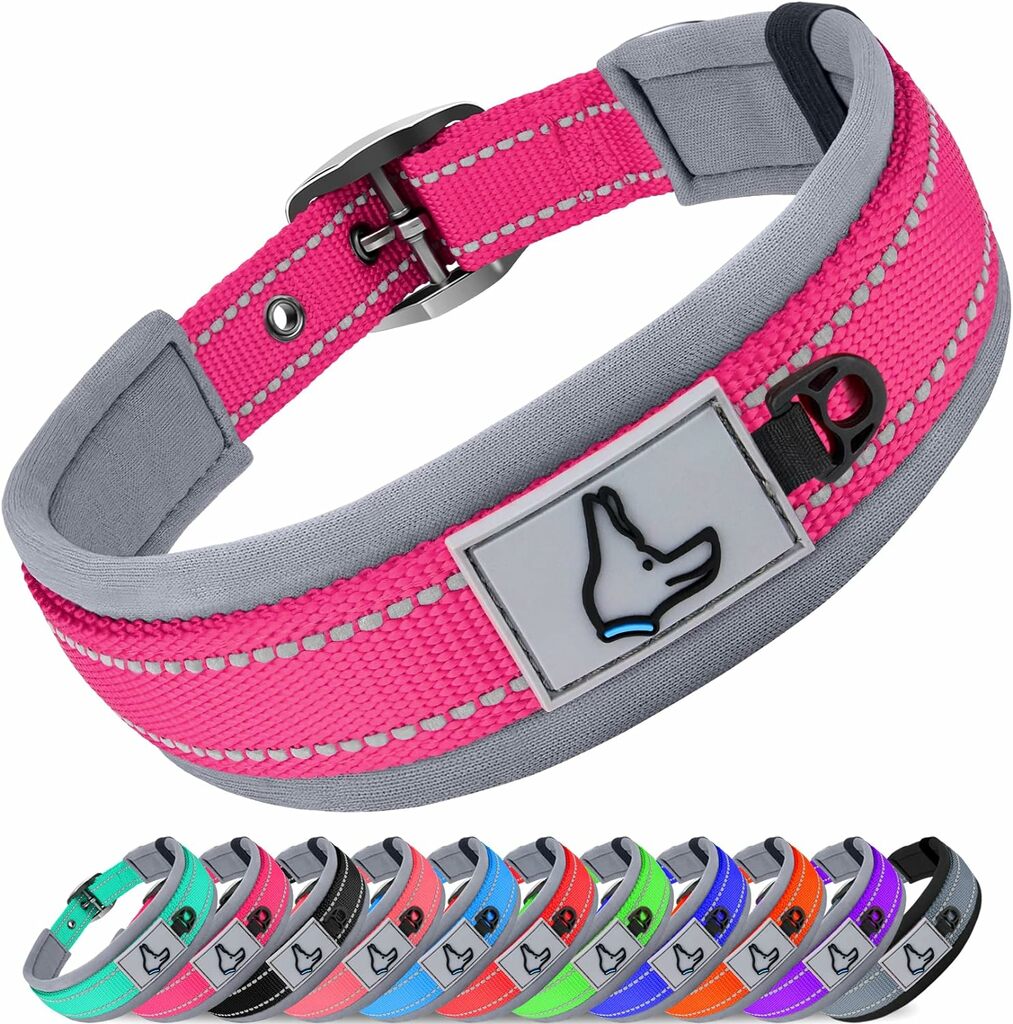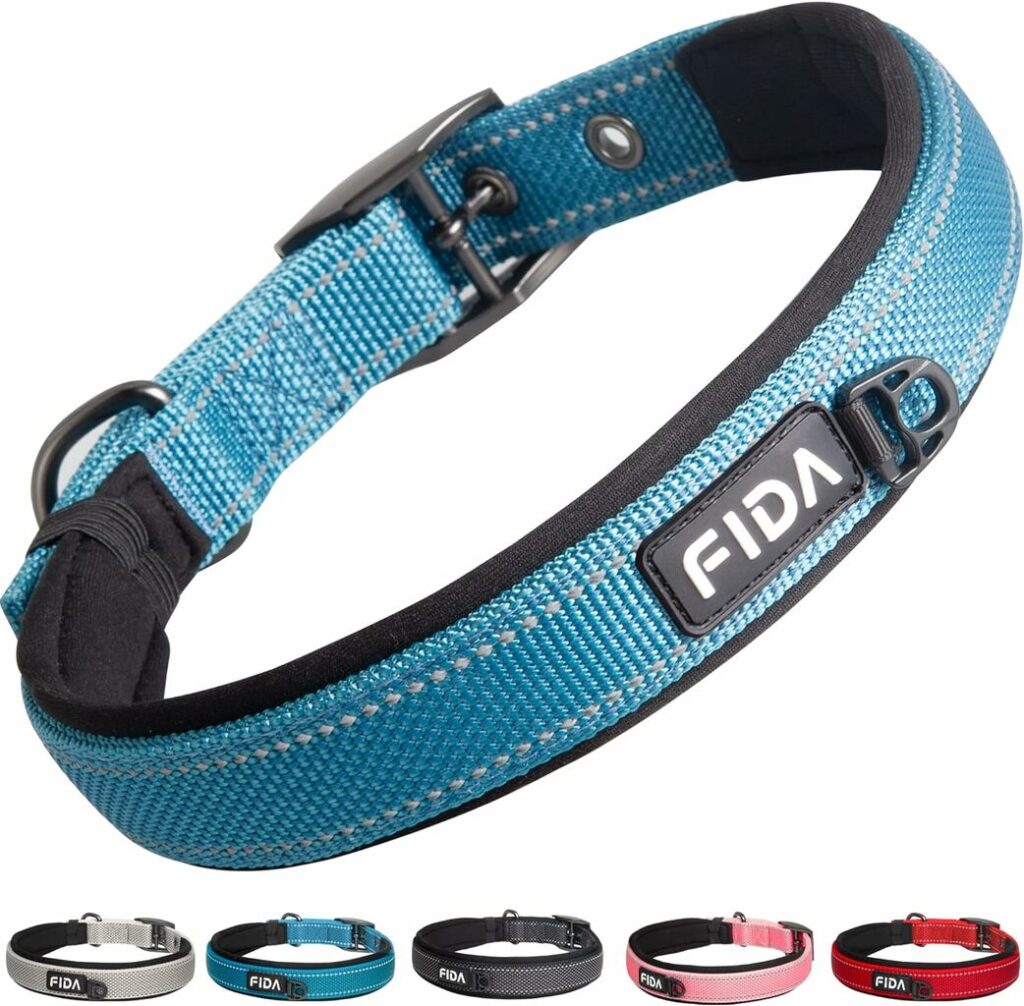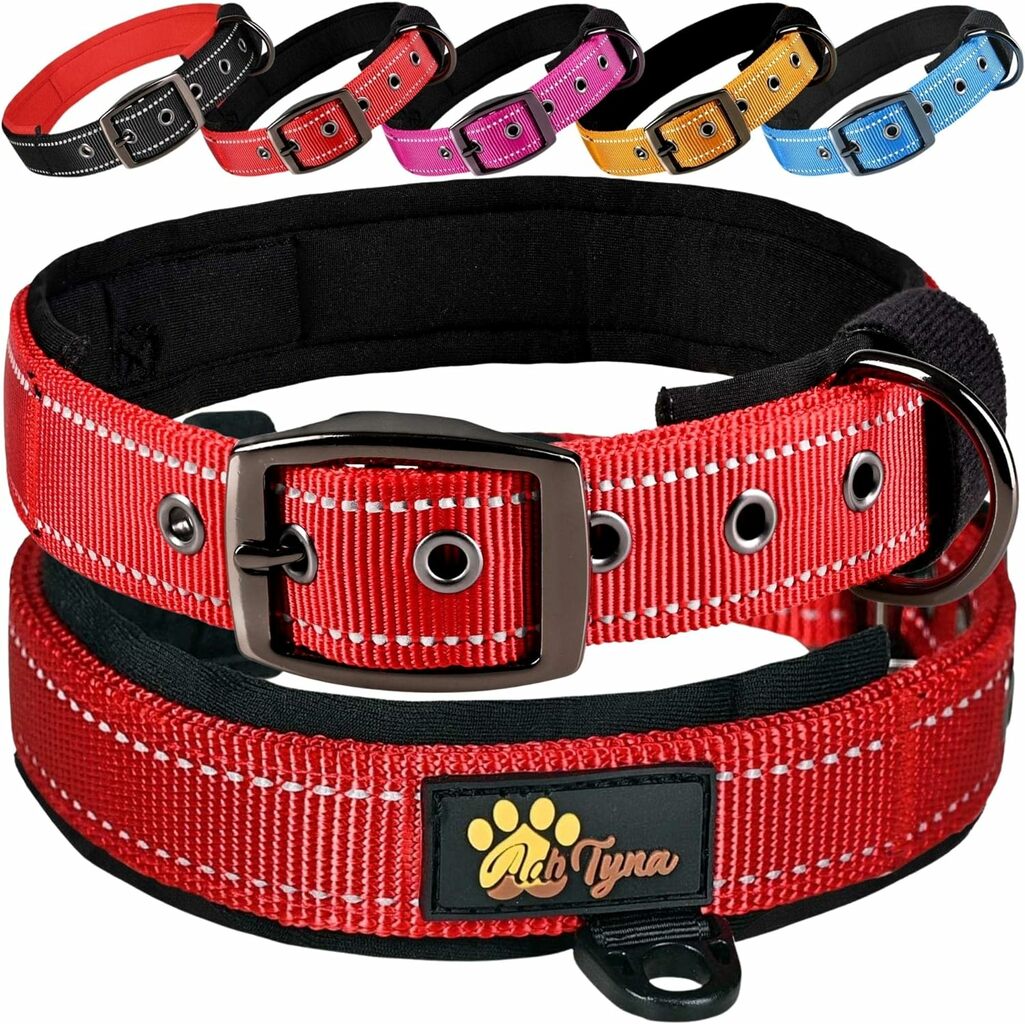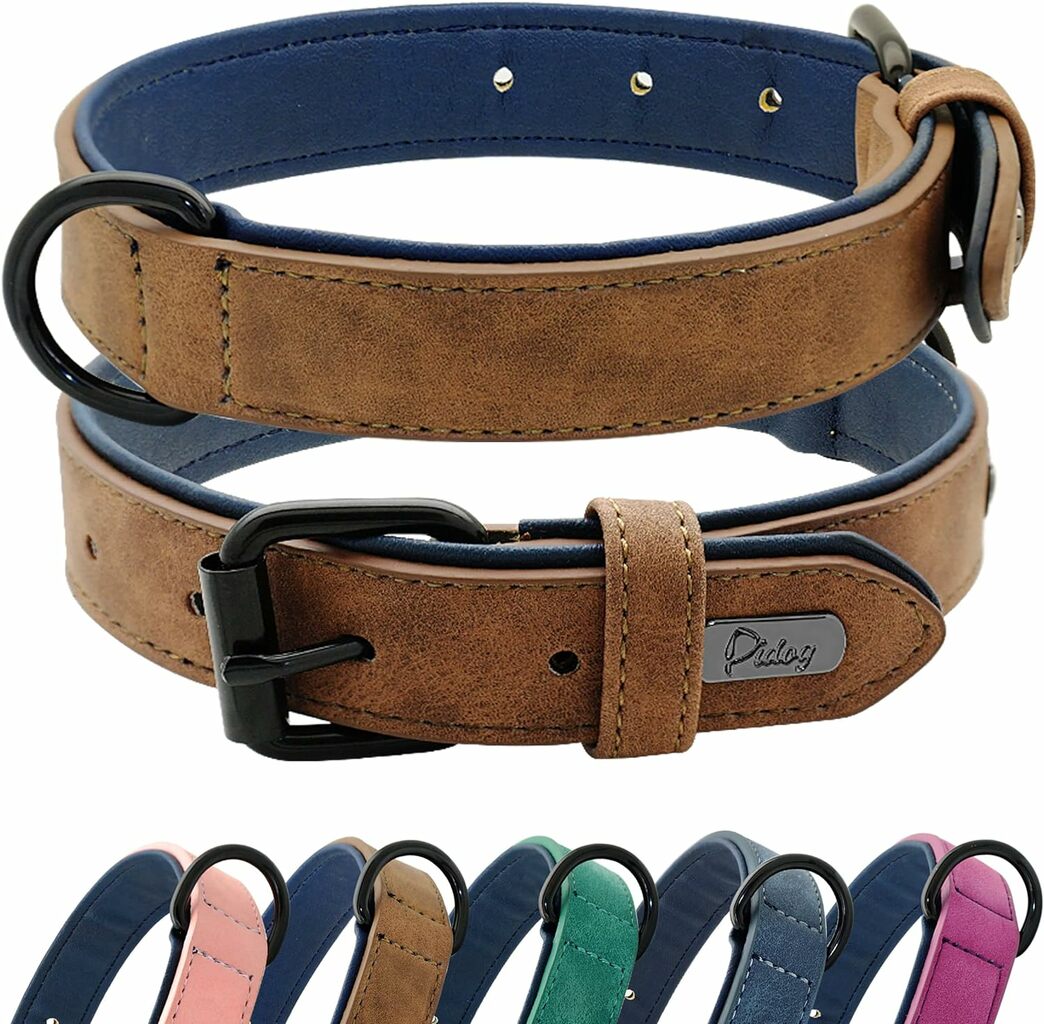As an Amazon Associate I earn from qualifying purchases.
Are you a dog lover who wants nothing but the best for your furry friend? Well, look no further! In this article, we will be exploring the world of dog collars and highlighting the best options available in 2024. From the timeless elegance of leather to the functionality of martingale collars, we will cover a wide range of styles and features to suit every dog’s needs. So, whether you’re in search of a collar for training purposes or simply looking to adorn your pup with a stylish accessory, we’ve got you covered. Get ready to see the top contenders for the title of the best dog collar in 2024!
Best Leather Martingale Dog Collar
Didog Soft Padded Leather Dog Collar
The Didog Soft Padded Leather Dog Collar is a reliable and durable option for dogs of all sizes. This collar is made from breathable and high-quality leather, ensuring comfort for your furry friend during walks or playtime. The adjustable rust-proof metal buckle adds to its durability, allowing for a secure and customizable fit. The brown color adds a stylish touch to your dog’s overall look. Available in various sizes, this collar is suitable for small, medium, and large dogs. Overall, the Didog Soft Padded Leather Dog Collar is a great purchase for pet owners looking for a basic yet dependable collar.
Soft, padded interior that’s comfortable for dogs
Adjustable buckle for a snug fit
Adjustable and available in different sizes and colors
Soft padding for extra comfort
Soft and comfortable
Usage: Dog training, Outdoor activities
Size: S
Lightweight: Yes
Pattern: Dog
Style: Elegant
Design: Soft Padded Leather

Best leather dog collar overall
Didog Metal Braided Leather Dog Collar
The Didog Genuine Leather Dog Collars are a stylish and functional choice for any dog owner. Made with high-quality leather and a metal braided design, these collars not only provide durability but also a touch of elegance. The adjustable feature ensures a snug fit for dogs of all sizes, while the wide nameplate allows for personalization with engraved information.
The black color adds a sleek and sophisticated touch to any dog’s appearance. With its attention to detail and craftsmanship, the Didog brand has created a collar that is not only durable but also customizable to fit each individual dog’s needs. Overall, the Didog Genuine Leather Dog Collars are a great investment for any dog owner looking for both style and functionality in their pet’s collar.
Personalized nameplate
Personalized with engraved nameplate
Customizable nameplate for personalization
Room for 3 trendy braids
Personalized with room for lots of info
Pattern: Dog
Material: Full grain natural genuine leather
Size: Large
Color: Black
Adjustable: Yes
Usage: Safe for baby dogs

Best dog collar for puppies
Joytale Reflective Dog Collar
The Joytale Neoprene Padded Dog Collars for Medium Dogs are an excellent choice for pet owners looking for a basic collar that offers functionality and style. With 11 vibrant colors to choose from, there is a collar to suit every dog’s personality. The reflective wide design ensures that your furry friend remains visible during evening walks, enhancing safety.
The durable metal belt buckle ensures a secure fit, preventing accidental escapes. The adjustable heavy-duty nylon material guarantees a comfortable fit for medium-sized dogs. The hotpink color adds a pop of brightness, making your dog stand out in a crowd. Overall, the Joytale Neoprene Padded Dog Collars are a reliable and stylish choice for pet owners in need of a functional collar for their medium-sized dogs.
Reflective stitching for increased visibility
Reflective for night walks
Comes in a variety of colors and patterns
Reflective stitching for added visibility at night or in low light
Reflective stitching for better visibility
Design: Dog
Material: Nylon
Package: 11 Colors
Feature: Quick-dry and odor resistance
Fit: Two fingers between the dog’s neck & collar
Adjustable: Heavy Duty Nylon

Best dog collar for comfort
Fida Reflective Nylon Pet Collar
The Fida Heavy Duty Dog Collar is a fantastic product for medium-sized breeds. The collar is made with high-quality nylon material that is both durable and comfortable for your furry friend. The neoprene padding provides extra cushioning, preventing any chafing or irritation on your dog’s neck. The adjustable feature allows for a perfect fit, ensuring that the collar stays securely in place. The reflective stitching is a great safety feature, making your dog visible at night. The metal belt buckle is also robust and long-lasting. Overall, the Fida Heavy Duty Dog Collar is an excellent choice for pet owners looking for a reliable and comfortable collar for their dogs.
Highly adjustable for perfect fit
Sturdy metal belt buckle
Adjustable and comfortable
Heavy-duty buckle and reflective details
Reflective for nighttime walks
Color: Blue
Size: 1 inch
Material: Nylon, Neoprene, Metal
For: Medium Breeds
Durable: Yes
Waterproof: Yes

Best Overall Dog Collar
ADITYNA Soft Neoprene Dog Collar
The ADITYNA Ultra Comfortable Soft Neoprene Padded Dog Collar for Large Dogs is a heavy-duty collar suitable for large breeds. The collar is made from high-quality neoprene material that ensures comfort for the dog, even during long walks or intense activities. The neoprene padding provides extra cushioning, preventing any discomfort or irritation on the dog’s neck. The collar is also adjustable, allowing for a perfect fit. It features a heavy-duty metal buckle and D-ring, ensuring durability and security. Overall, this collar from ADITYNA is a reliable, comfortable, and practical choice for large dog owners.
Adjustable length
Reflective stitching for nighttime safety
Reflective stitching for added visibility
Comes with a free 7-inch leash
Reflective stitching
Material: Lightweight Double Nylon
Weight: 1.2”
Closure: Premium Double Buckle
Size: 19-23 inches
Pattern: Reflective stitching
Design: Soft Neoprene Padded
What is the best type of collar for a dog?
Choosing the right collar for your furry friend can be a daunting task, as there are so many options available on the market. However, when it comes to finding the best type of collar for your dog, it ultimately depends on the specific needs of your pet. There are several factors to consider, such as the size and breed of your dog, their behavior, and any specific training requirements.
One of the most popular and versatile types of dog collars is the traditional flat collar. These collars are typically made of nylon or leather and feature a buckle or quick-release fastener. They are great for everyday use as they are comfortable and provide a secure hold on your dog’s neck. Flat collars are suitable for most dogs, particularly those who are well-behaved and don’t require much training or correction.
However, if your dog tends to pull on the leash during walks or requires more control, a martingale collar may be a better option. Martingale collars consist of a wide, flat collar with an additional loop that tightens when pulled, preventing your dog from slipping out of the collar. They are particularly useful for dogs with narrow heads, such as greyhounds or whippets, as they provide control without choking or causing discomfort.
For dogs who have a tendency to pull excessively or require training, a head halter collar can be a game-changer. This type of collar allows you to control your dog’s head movement, similar to how a horse is guided with reins. Head halters are effective in reducing pulling and redirecting your dog’s attention during walks. However, it’s important to properly introduce and train your dog to accept the head halter collar to ensure their comfort and safety.
When it comes to choosing the best type of collar for your dog, it’s crucial to prioritize their safety, comfort, and specific needs. Consider consulting with a professional dog trainer or veterinarian to determine the most suitable collar for your furry friend. Remember, a well-fitting collar is essential, so regularly check for any signs of wear or discomfort, and always adjust the collar to ensure a proper fit.
Is it better to use a harness or collar?
When it comes to walking our furry friends, one question that often arises is whether to use a harness or a collar. Both have their advantages and disadvantages, but the choice ultimately depends on the individual dog’s needs and behavior. Let’s explore the benefits and drawbacks of each option to help pet owners make an informed decision.
Collars are the traditional choice for dog walking and are readily available in a variety of styles and materials. They can be easily slipped on and off, making them convenient for quick outings. However, collars can pose a risk to some dogs, especially those prone to pulling. The pressure applied to the neck during walks may strain the delicate structures in their throat, leading to health issues. Additionally, for dogs with respiratory problems or small tracheas, collars can further exacerbate their conditions.
On the other hand, harnesses offer a safer and more comfortable walking experience for both pets and owners alike. By distributing the pressure across the dog’s chest and back, harnesses reduce strain on the neck and throat. This is especially beneficial for dogs prone to pulling, as it minimizes the risk of injury. Harnesses also provide more control over the dog’s movements, making training and discipline easier. However, keep in mind that certain breeds, like Greyhounds or Whippets, might have a higher likelihood of escaping from a harness due to their slim bodies.
Ultimately, the choice between a harness and a collar should prioritize the well-being of the dog. Consulting with a veterinarian or professional dog trainer can help assess the specific needs of your pet and guide you in making the best decision. Remember, the most important thing is to ensure the comfort and safety of your beloved four-legged companion during those enjoyable daily walks.
How tight should a dog’s collar be?
Dog Collar are an essential accessory for every dog owner. They not only serve as a means of identification but also help in controlling and training our furry friends. However, when it comes to the tightness of the dog collar, it is crucial to strike the right balance. It’s important to ensure that the collar is neither too loose nor too tight.
A collar that is too loose can easily slip off or become entangled in objects, putting the dog’s safety at risk. On the other hand, a collar that is too tight can cause discomfort, choking, and even injury to the dog. It is important to find the middle ground where the collar fits snugly while allowing enough room for comfortable movement.
To determine the right tightness, you should be able to slip two fingers comfortably between the collar and your dog’s neck. This allows the collar to be snug enough to prevent slipping, yet loose enough to avoid any constriction. Regularly check your dog’s collar to ensure that it hasn’t become too tight due to growth or weight gain. Adjust the collar accordingly to maintain its proper fit.
Remember, the primary purpose of a dog collar is safety and control. It should fit securely to prevent escape, but never compromise your dog’s wellbeing. Always prioritize your dog’s comfort and strive for the perfect balance when it comes to the tightness of their collar. With the right fit, your dog can wear their collar with confidence and security.
Are some dog breeds more suited to specific types of collars?
When it comes to choosing a collar for your beloved furry friend, there are numerous options available on the market. From traditional buckle collars to martingales and harnesses, it can be overwhelming to decide which type is best for your dog. But have you ever wondered if certain dog breeds are better suited to specific types of collars?
The answer is yes, to some extent. Different dog breeds have unique physical characteristics and behavioral tendencies that may make certain collars more suitable for them. For example, breeds with short snouts, such as Pugs and Bulldogs, may benefit from harnesses rather than traditional collars to avoid putting too much pressure on their respiratory systems. Similarly, larger breeds that are prone to pulling, like Huskies or Boxers, may do well with a martingale collar that provides more control without choking or hurting them.
However, it’s essential to remember that every dog is an individual, and what works for one breed may not work for another. Factors like size, age, and training history also come into play when selecting a collar. It’s crucial to consult with a professional trainer or veterinarian to assess your dog’s specific needs and determine the most appropriate collar type.
Ultimately, the comfort and safety of your dog should be the top priority when choosing a collar. Ensure that the collar fits properly, allowing enough space for movement while not being too loose. Look for collars made from durable materials that won’t cause irritation or discomfort. Remember that the purpose of a collar is to provide identification, leash attachment, and control, so choose one that fulfills these functions effectively.
In conclusion, while certain dog breeds may benefit from specific types of collars, there is no definitive rule. It’s essential to take into account your dog’s individual characteristics, as well as seek professional guidance when making a choice. Prioritize your dog’s comfort and safety, and you’ll surely find the perfect collar that suits your furry friend’s needs.
Do dogs need a collar?
When it comes to managing our four-legged friends, many dog owners wonder if their pets really need to wear a collar. While it may seem like an unnecessary accessory, dog collars serve multiple purposes that are beneficial for both pets and their owners. The most obvious reason is identification. A collar with your dog’s name and your contact information can be a lifesaver if your furry friend ever gets lost. It’s the fastest way for a stranger to contact you and ensure your dog’s safe return home. Additionally, collars can be used for training purposes. Training collars, such as choke or prong collars, help improve behavior by providing gentle corrections. This is especially useful for dogs who tend to pull on the leash or exhibit other undesirable habits. Lastly, a collar can act as a fashion statement. There is a wide variety of stylish collars available that allow owners to express their pet’s personality and add a touch of flair to their appearance. From personalized designs to trendy patterns, dog collars offer a fun way to accessorize while ensuring your pet’s safety and well-being. So, whether it’s for identification purposes, training, or just to make your pup look fabulous, it’s clear that dogs can benefit greatly from wearing a collar.
Can dogs sleep with collars on?
Many dog owners wonder whether it is safe for their furry friends to sleep with their collars on. While some may argue that a dog should always wear a collar for identification purposes, others believe that it is best to remove it at night. Ultimately, the decision should be based on the individual dog’s needs and circumstances.
One concern with leaving a collar on during sleep is the potential for accidents. If a dog’s collar gets caught on something while they are sleeping, it can lead to injury or even choking. This risk is especially high if the collar has tags or is too tight. Therefore, it is essential to ensure that the collar fits properly and is not too loose or too tight.
Another consideration is the comfort of your furry companion. Some dogs may find wearing a collar uncomfortable and may have difficulty relaxing and sleeping peacefully. In such cases, it may be best to remove the collar at night to provide them with a more comfortable sleep environment.
On the other hand, there are advantages to keeping a dog’s collar on at night. If your dog tends to be an escape artist, removing their collar can increase the risk of them getting lost. Additionally, having identification tags readily available can be crucial in the event that your dog wanders off or is involved in an accident.
In conclusion, whether or not a dog should sleep with a collar on depends on various factors. It’s crucial to assess the individual dog’s needs and safety risks. If you decide to leave the collar on, ensure that it fits properly and does not pose a risk of getting caught on anything. Alternatively, if you choose to remove it, make sure your dog is properly identified in case they wander off. Understanding your dog’s specific needs and prioritizing their safety and comfort will guide you in making the best decision.
Should I take my dog’s collar off at night?
Many dog owners wonder whether they should take their dog’s collar off at night. While there is no strict rule, it is generally recommended to remove your dog’s collar before bedtime. Here’s why.
Firstly, safety is a primary concern. Dogs can sometimes get their collar stuck on furniture, door handles, or even themselves. This can lead to potential accidents and injuries. By removing the collar at night, you eliminate the risk of your dog getting caught on something while you’re asleep. This will give you peace of mind and ensure your furry friend’s safety.
Secondly, taking off your dog’s collar at night allows their skin to breathe and rest. Collars can sometimes cause irritation, especially if they are worn continuously. By giving their neck a break during sleep, you prevent any potential discomfort or rubbing. It’s a simple way to promote better skin health and overall comfort for your dog.
Lastly, removing the collar at night can also prevent noise disturbances. Most dog collars have tags that jingle or jangle when the dog moves, which can be disruptive during quiet hours or when you’re trying to sleep. By taking off the collar, you can enjoy a peaceful and uninterrupted night’s rest.
It’s important to note that there are exceptions to this rule. If your dog has identification or tags containing essential information, you may want to consider using a breakaway collar designed for safety. These collars are designed to release if they get caught on something, reducing the risk of choking or getting stuck. Ultimately, the decision is up to you as the owner and what you feel is best for your dog’s safety and well-being.
In conclusion, while there is no hard and fast rule, it is generally recommended to take off your dog’s collar at night. This practice promotes safety, allows your dog’s skin to breathe, prevents noise disturbances, and ensures a peaceful night’s sleep for both you and your furry friend. Consider using a breakaway collar if your dog needs identification tags. Remember, always prioritize your dog’s safety and comfort.
How do I measure my dog for a collar?
If you have recently gotten a new furry friend or if your current dog has outgrown their collar, you may be wondering how to measure your dog for a collar. Ensuring the right fit is essential for your dog’s comfort and safety. Here are some simple steps to help you accurately measure your dog’s neck size.
First, gather a flexible measuring tape or a piece of string and a ruler. It’s important to use a flexible measuring tool rather than a rigid one, as it will provide a more accurate measurement. Start by finding the base of your dog’s neck, which is the area where the collar will sit. This is usually right near the shoulder blades.
Next, wrap the measuring tape around the base of your dog’s neck snugly, but not too tight. If you’re using a piece of string, wrap it around the neck and mark the point where the ends meet. Then, lay the string flat and measure the marked length with a ruler.
Once you have obtained the measurement, add an additional inch or two to ensure a comfortable fit. This will allow room for any potential weight gain or growth spurts. Now you can use this measurement to find the appropriate collar size for your dog, taking into account the collar’s adjustable range.
Remember, a well-fitted collar should be snug enough to prevent your dog from slipping out, but not too tight that it causes discomfort or restricts their breathing. A properly fitted collar will ensure their safety during walks or any other activity.
Does a collar fit by breed?
Choosing the right collar for your furry friend is an important decision. With so many different breeds of dogs, you might wonder if there is a one-size-fits-all collar or if you need to consider the specific breed when making your selection. The truth is, while some collars may be more suitable for certain breeds, there is no definitive answer. The size, temperament, and individual needs of your dog are the key factors to consider.
When it comes to finding the right collar for your dog, the most important consideration is the size. Smaller breeds will obviously require a smaller collar, while larger breeds will need a collar with a wider girth. However, it is not just about the length of the collar, but also the width. Breeds with longer necks, such as Greyhounds, may benefit from a wider collar to distribute pressure evenly. On the other hand, smaller breeds like Chihuahuas may be more comfortable in collars that are thinner and lighter.
Aside from size, you also need to take into account your dog’s temperament and specific needs. For example, some breeds are more prone to escaping or pulling, requiring a collar with strong durability and a secure fastening mechanism. Certain breeds may have sensitive skin, making it important to choose a collar made from hypoallergenic materials. Additionally, dogs with thick fur may need adjustable collars that can accommodate their changing coat length.
Ultimately, the key to finding the right collar lies in knowing your dog and understanding their individual requirements. While certain collars may be more commonly used for specific breeds, it is not a one-size-fits-all scenario. Consider your dog’s size, temperament, and specific needs when selecting a collar. When in doubt, consult with a professional to ensure you make the best choice for your beloved pet. Remember, a comfortable collar is essential for your dog’s well-being and safety.
As an Amazon Associate I earn from qualifying purchases.

